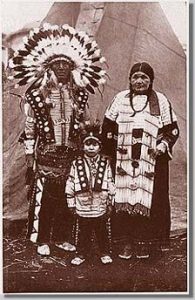The Native American Indians of Delaware were called as the “Lenni Lenape” who lived in Delaware, New York, New Jersey and Pennsylvania. A river in Delaware runs in these states and across their land. Lenni Lenape was divided into three factions, the Munsee, Unami, and the Unalachtigo. They spoke different dialects of the Algonquian language which was known as Lenni. Lenape is pronounced as “Leh-nah-pay” meaning “the people”. It is sometimes spelled as Lenapi or Lenape. They can be called as Lenni Lenape meaning “true people” or Delaware Indians derived from Delaware River.
Native American Indians of Delaware

There was an estimate of 9,000 – 12,000 Delawares in the U.S. before Europeans arrived. Some studies believed that this number may have been multiplied. Sometimes, they were divided into as much as 20 tribes. They had a network of villages where each village was surrounded by independent hunting territories. The villages were located along streams and rivers as well as the Delaware River.
The Lenni Lenapes were originally from the mid-Atlantic area. Most Lenape Indians were taken out of their native land by the British. The Americans finally moved them towards Oklahoma where the present-day Delaware tribes are located while other Lenapes joined the Munsee Delaware or Nanticoke. Some small Lenape communities remained in Pennsylvania and New Jersey. It was said that the entire population of Lenape was 16,000 people.
The two federally acknowledged Lenape tribes in Oklahoma are the Delaware Tribe of Western Oklahoma and the Delaware Tribe of Indians. Like other indigenous American tribes, they are also independent, meaning they have their own government, policies, laws and services like in a small county. Nevertheless, the Delaware are U.S. citizens and must follow U.S. law. The U.S. government does not formally recognize the Lenni Lenapes in Pennsylvania and New Jersey indicating that they have no reservation land or own government organization although they can still observe the Lenape culture. All Lenapes today speak in English. Elder Lenapes, however, still speak Unami which is the native Lenape language. Some young Lenape is learning their ancient language again.
Children Lenapes do the same things like other children do. They also play, go to school and assist in their house. Most Lenape children like hunting and fishing. Just like the children from the early colonial era, Indian kids had more responsibilities and less playing time. Lenape kids had dolls and toys too like small bows and arrows. The games for Lenape teens and adults were lacrosse which was played by boys or men only and a football game which can be played by both genders together. The Lenape mothers usually carried their babies using a native cradleboard placed on their backs which were adopted by most American parents now.
The Lenapes are known for their basketry and beadworks. Like other Native American Indians, Lenapes too crafted wampum beads which were traded as a form of currency. Wampums were more recognized as art materials because the pictures and designs often had a meaning or story about the person’s family.
